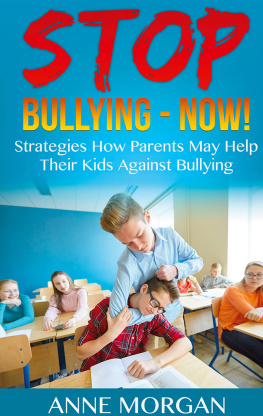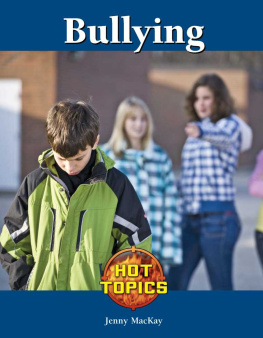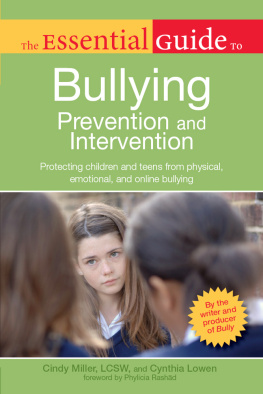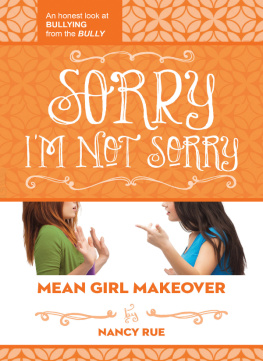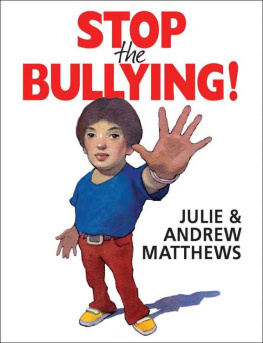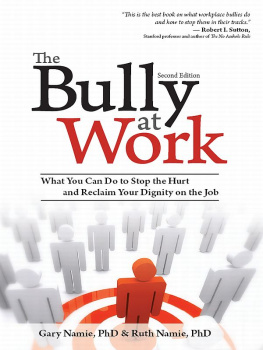Copyright 2016 by Andrew Faas. All rights reserved.
The use of any part of this publication reproduced, transmitted in any form or by any means, electronic, mechanical, photocopying, recording, or otherwise, or stored in a retrieval system, except for brief excerpts in a review or essay referring to this book, without the prior written consent of the publisher or, in case of photocopying or other reprographic copying, a license from the Canadian Copyright Licensing Agency is an infringement of the copyright law. For information, contact info@rcjpress.com.
In the stories I tell, some names and identifying details have been changed to protect the privacy of individuals and organizations.
Is Your Workplace Psychologically Safe?
The workplace is the most dangerous place to be in America.
US Department of Justice (Grimme)
Abuse // Coercion // Discrediting // Exploitation // Extortion // Harassment // Intimidation // Threats = Bullying in the Workplace
Is your workplace psychologically safe? This is the question that everyone in an organization, at every level, should be asking in a critical way.
Many people I have spoken to, when they hear the word bullying, relate it to what occurs in schools and usually think what goes on in the workplace is the norm. They do not associate the actions or behaviors with bullying. However, when I describe the dynamics of bullying, which include the words abuse, coercion, exploitation, extortion, harassment and threats, it instantly resonates and people acknowledge the unnecessary stress caused by bullying.
During and after writing my first book, The Bullys Trap: Bullying in the Workplace, I received a lot of pushback from executives who believe that my findings and assertions are extreme exaggerations. Most claim the level of discontent and fear is not the case in their organizations, citing positive engagement surveys, robust policies and procedures, methods by which employees can provide honest feedback, enlightened human resource professionals, and sensitivity, diversity and sexual harassment training.
My usual response is that they are fortunate and unique, because this is not the case in most organizations. Most midsized to large organizations have all of the elements in place that defensive executives cite, yet most of these organizations are not truly psychologically healthy, safe and fair. The research I completed and comments I received since the book was published suggest that my earlier findings and assertions were definitely not extreme exaggerations. In fact, the findings do not adequately describe how bad it is out there.
My initial mission in writing The Bullys Trap was to start a debate about that very subject. However, over the course of my journey learning about workplace bullying, I discovered that the issue is much broader than that. Its not just a matter of bullying in the workplace entire workplace cultures in many organizations are built on foundational principles that guarantee a toxic environment for all, not just a few select victims of particularly vitriolic harassment.
Gallup polling shows that more than 70 percent of North American workers are not engaged. My findings suggest that most are not engaged because they do not respect and/or trust their bosses and, by extension, the organization itself; and many spend the bulk of their waking hours living in fear. Case in point: a Harvard study called The Relationship between Workplace Stressors and Mortality and Health Costs in the United States reports that more than 120,000 deaths annually may be attributable to workplace stress.
Since the publication of The Bullys Trap, there have been numerous examples of psychologically unsafe workplaces in the press, the most notable being Amazon, Wells Fargo and Volkswagen, which I will get into in more detail in the book. These examples reinforce some of the findings and assertions I made in The Bullys Trap . Unfortunately, in politics, Donald Trump has become a role model for what I refer to as the CBO, or Chief Bullying Officer.
It is a basic and fundamental right of everyone to live, learn, worship, work and play in a safe and protected environment.
An unsafe environment is one in which people are physically and mentally harmed, and/or under the threat of being harmed. Bullying is the most common dynamic in a psychologically unsafe environment. The issue of school bullying has received considerable exposure, largely due to the incidences of suicide where bullying is a factor. By comparison, there is relatively little published material on workplace bullying that raises awareness about it, discusses its effects on employees, and provides practical prevention solutions the prerequisite being: creating a psychologically safe and productive workplaces.
Considering how little substantive research has been conducted on the field of workplace bullying, I have been working together with my foundation, The Faas Foundation, and the Yale Center for Emotional Intelligence to launch an extensive survey that will gather evidence about the organizational benefits of psychologically safe workplaces. The goal of the survey, called the Emotion Revolution in the Workplace, is to understand how employees feel about work, and why they feel the way they do. Additionally, the Emotion Revolution will analyze how these emotions impact key outcomes, like employee physical and mental wellness, individual and organizational performance, and other important workplace elements like creativity, innovation and freedom of expression. The survey will be comprehensive in that it will gather opinions from all levels of employment and from a widespread collection of different job markets. The study is patterned after a similar initiative conducted by Yale on high school students across the U.S.
While there are some overt similarities between school and workplace bullying, workplace bullying is far more subtle and complex. Most targeted individuals do not realize what is happening to them until they are well into the situation (usually too late) and become what the bully wants them to become: a poor performer with a bad attitude the villain rather than the victim.
You will note that I have not devoted much of this work to the rehabilitation of the bullies. Many believe bullying is a learned behavior and can be unlearned. This may or may not be true; however, I question the efficacy of this. Rather, the focus here is, as Oscar Wilde so aptly put it, Its the prisons, not the prisoners who need the reformation. Bullies bully because they can. In many organizations, they are considered the heroes, and people at the top condone, accept and even expect bullying and fear as a motivational method. It is also interesting to note more than 70 percent of bullying is by the boss to the employee.
Psychologically unsafe workplaces have catastrophic consequences. They can ruin careers, destroy family units, ruin organizations, cause people to attempt or commit suicide, and kill others.
Creating a psychologically safe and productive workplace is everyones responsibility; however, it must be driven and led by the very top the Board of Directors and the CEO.
In From Bully to Bulls-Eye, I challenge those who work in toxic cultures to become witnesses, defenders, and activists, never having to regret saying:
- I could have prevented the ruining of my coworkers career.
- I could have prevented the break-up of a family unit.
- I could have helped prevent the demise of an organization.
- I could have deterred a suicide or attempted suicide.



